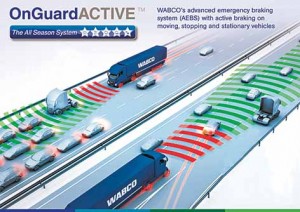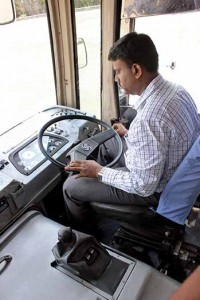CVs in India are speeding down the connected vehicles path.
Story by: Bhushan Mhapralkar
The move up to BSIV emission regulations has changed the way technology hereafter will find its way into Indian CVs. The rise in electronic content has opened up so many possibilities, that connected CVs are just a matter of time. Fully autonomous vehicles are still some distance away, the same cannot be said about connected vehicles. The technologies that will help to build a connected CV are already there, and there is no curbing the steady progress. A matter of market acceptance and demand, connected CVs, particularly Heavy Goods Vehicles (HGVs), with an ability to connect to the cloud, will change the way the driver looks at his role. Also set to change is the way a fleet operator and the respective manufacturer will function. Averred Vinod K. Sahay, Chief Executive Officer, Mahindra Trucks and Buses, “We are not far from truly connected CVs. It is the cost that has to be justified.” “Regulatory push makes it easier but the challenge lies with the operation getting the price from the consumer. What goes into a CV someone has to pay for it,” he stated.
Linked with infrastructure development and economic standards, connected CVs will find it easier with the elimination of state border checks. Set to spend increasingly less time off the road, and at truck stops, the opportunity to fine-tune the hub and spoke transportation model only grows, as e-way bills turn into an efficient transporter’s tool, the transport industry, to tide over the shortage of skilled drivers, will increasingly turn to connected vehicles. Faster turnaround time and better planning will be attained. Safety will go up, and encourage the consignor to pay more. If this makes it trickier for skill developers that train CV drivers, connected CVs will not replace the driver. They will make him and the ecosystem around him more efficient. According to Jacques Esculier, Chairman and Chief Executive Officer, Wabco Inc., connected CVs will soon be a reality. Drawing attention to a new strategy developed by his company in that direction, Esculier stated, “We are piloting lane departure warning system for India.” Wabco has acquired a leader in fleet management solutions in Europe. In India, it has developed a product that is essential to connect the trucks to the ground. It simultaneously gathers information on fuel consumption, driver behaviour, etc., and processes as well as transmits it.
Considering the availability of infrastructure, or the lack of it, and the road manners, Wabco’s piloting of a lane departure warning system hints at the achievement of a significant stage in the development of connected CVs in India. It may draw from a system that is working successfully in Europe or US, for application in India will require much adaptation.Encouraging Wabco to pilot a lane departure warning system is the way traffic on highway moves. Indian highway driving are getting closer to the way Europeans drive on their highways. But then, it is not just about the lane departure system. The advent of ABS has already indicated the rising use of electronics. With efficiency and safety at the core, electronics is rapidly setting the tone for connected CVs. A Frost & Sullivan report, ‘Global Connected Truck Telematics Outlook 2017’ has stated that the growth of internet and GPS enabled solutions has come to incorporate additional value chain participants such as content providers, application providers (for applications like distracted driving), and wireless providers. Mentioned Mamatha Chamarthi, Chief Digital Officer, ZF, that they are looking at many things. Transmissions in CVs for example, that can be connected and monitored to help with remote diagnostics and prognostics. According to ZF CEO Dr. Stefan Sommer, it is about life spent in different ways for the end customer. With the need to comply with occupant safety rising, connected CVs are set to be a reality sooner than later.
Bringing to India a host of technologies like air disc brakes, Autonomous Emergency Braking (AEB), stability control and others, suppliers like Wabco and ZF are striving to ensure that no feature on offer is not adaptable. Stress is on developing functions that specifically address the Indian environment. One development that stands out is Automated Manual Transmission (AMT). It takes away the task of operating the clutch and changing the gears from the driver. Communicating with the engine and the other elements that are electronically powered (ABS, AEB, traction control, etc.) to formulate the right shifting strategy. AMT elevates efficiency, safety and comfort – the three hallmarks of connected vehicles. AMT also adds a dimension to how a connected CV will communicate with the operator and the manufacturer.
For a manufacturer, connected CVs will provide big and valuable data. They will provide data that would help the manufacturer to make reliable vehicles. Vehicles that are smart and profitable. With the time spent on the road by a CV rising, especially in the case of HGVs and long-route buses, the availability of data to manufacturers is helpful in scheduling preventive maintenance, offering quick breakdown support, and in collecting necessary data on vehicle behaviour. For an operator, the connection would ideally indicate where his or her HGV is, about driver behaviour, and more. Offering the driver an opportunity to self evaluate his driving skills, and drive better, a connected CV will also enable a fleet operator to keep tabs; for the insurance company to charge lower premium, or a premium based on wage. Describing connected CVs as a new area of value to the CV industry, and the transportation industry, Esculier averred, “It is a completely new area of value that our industry would provide to fleets.
As connected CVs emerge, the role of the driver will change. He will drive as well as manage the business pertaining to his truck, albeit with the help of his fleet manager until a fully autonomous form is arrived at. If a connected CV will help to lower the insurance premium, a feature like AMT will provide better comfort. AEB and lane departure warning system will improve safety. Telematics will ensure that the operator and manufacturer are informed. The driver, will have knowledge about the route, health of his vehicle, and if he has to alter his driving style or the route. Driver skill development will have to be suitably modified, and dealers will have to modify the way they conduct their business, connected CVs will make an efficient interface that benefits all.























